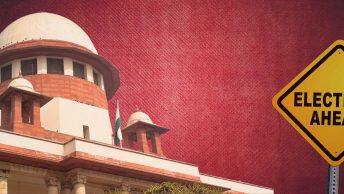Summary: This article delves into the recent criminal law bills introduced in India, specifically focusing on the proposed replacement for the sedition law. It critically analyzes the transition from Section 124A to the new Section 150 of the Bharatiya Nyaya Sanhita Bill (BNS), offering insights into the implications of the new law on democratic principles and the potential for misuse.
Introduction
While Shakespeare mused that a rose by any other name would smell as sweet, the recent criminal law bills suggest that a thorn by any other name pricks as sharply. India is at a critical juncture, as three new criminal law bills—including a proposed replacement for the existing sedition law—present a potential flashpoint for civil liberties.
In 2020, the Central Government set up a Committee for Reform in Criminal Law to review the three codes of criminal law in India. Meanwhile, in S.G. Vombatkere v. Union of India (2022), the Supreme Court stayed the application of all Section 124A of the Indian Penal Code cases, prompted by the government seeking time to reconsider the provision in light of human rights and civil liberties concerns. The 279th Law Commission Report (“Report”) was released after the Court’s decision. The Report, inter alia, suggested various procedural safeguards and examined whether the sedition law was colonial. However, the Report offered a myopic view of colonialism, treating it merely as a temporal moment in history rather than a system of oppression. It remains unclear whether the Committee for Reform in Criminal Law, took this Report into account, given the conspicuous lack of transparency in disclosing their methodology and recommendations. On August 11, 2023, Home Minister Amit Shah unveiled a trio of sweeping criminal law bills in the Lok Sabha, asserting that these legislative measures would expunge vestiges of colonial subjugation and eliminate the existing sedition law.
Yet, upon close examination, the new criminal law bills reintroduce a sedition-like provision in Clause 150 of the Bharatiya Nyaya Sanhita Bill (“BNS”). Renamed as “Acts Endangering the Sovereignty, Unity and Integrity of India,” this section expands the scope and severity of punishable acts and amplifies punitive measures against democratic dissent. This legislative move appears to circumvent the Supreme Court’s stay on Section 124A in the Vombatkere case, rather than addressing the human rights concerns that led to the stay. The rebranding and intensification of the sedition law can be seen as an Orwellian maneuver—erasing the distinction between the oppressed and the oppressor, and reinforcing systems of control under the guise of legal reform. This article is twofold: Section I attempts to examine judicial trends in how sedition has been interpreted by the Courts, while Section II scrutinizes the provisions of the new law on sedition, highlighting its (a) ambiguities and oversights, (b) inclusion of electronic communication and financial avenues, (c) lack of adequate procedural safeguards, and (d) departure from Kedar Nath.
Examining Judicial Trends
The trajectory of sedition jurisprudence in India constitutes a nuanced struggle between its colonial inheritance, national security exigencies, and democratic ideals. The interpretation of Section 124A in Queen Empress v. Bal Gangadhar Tilak reveals a colonial stance, construing mere ‘feelings of disaffection‘ towards the government as seditious. These included sentiments encompassing hatred, enmity, and contempt. Post-independence, the Delhi and Punjab and Haryana High Courts deemed Section 124A to be unconstitutional due to its overtly colonial nature. However, a significant shift occurred with the First Amendment to the Indian Constitution in 1951. The revised Article 19(2) removed the phrase about overthrowing the state as a condition under which speech could be restricted, and replaced it with broader exceptions to free speech. It introduced two new grounds for restricting speech: public order and incitement to an offense. This shift came as India faced communal tensions and territorial threats, and was seen as necessary for national unity.
Accordingly, the Supreme Court in Kedar Nath Das v. State of Bihar upheld the constitutionality of Section 124A, but read it down to only apply to acts involving incitement to violence or disturbance of public order. This restrictive interpretation persisted in decisions such as Balwant Singh v. State of Punjab, which underscored the significance of immediate incitement. Further, in Shreya Singhal v. Union of India, a ‘tendency test‘ was adopted, asserting that mere government disaffection is not sedition unless it jeopardizes public order. Furthermore, the Court in Gurjatinder Pal Singh v. State of Punjab ruled that even explicit demands for secession and the establishment of a separate State need not constitute a seditious act.
The arc of these judgments showcases a transition away from Section 124A as a stringent colonial tool designed to suppress dissent. This transition moves towards a more nuanced understanding that aligns more closely with democratic values. This alignment emphasizes the paramount importance of freedom of expression. However, it remains entangled with the complex historical baggage, as this law was initially crafted under the influence and control of colonial powers.
Examining the New Law
This section delves into the evolving scope and language of Section 124A and Clause 150, highlighting the broadening of offenses related to political dissent and national security in India. It underscores the potential overreach and ambiguities in the proposed legislation, emphasizing the implications for freedom of expression, democratic principles, and the potential for misuse. The comparison with previous legal recommendations and international parallels attempts to offer a comprehensive perspective on the challenges and nuances of sedition law reforms.
Ambiguities and Scope for Exploitation
The comparison of Section 124A and Clause 150 reveals a significant shift in the scope and language surrounding the offenses. Section 124A targets acts or words that bring disaffection, contempt, or hatred towards the Government. Section 150 widens this scope, encompassing secession, armed rebellion, subversive activities, and encouragement of feelings of separatist activities. This broadening appears to echo the recommendations of the 42nd Law Commission Report (1971). Specifically, the 1971 report sought to broaden the mens rea element in crimes related to sedition by focusing not merely on acts that caused disaffection toward the government, but also on those endangering the integrity or security of India or causing public disorder. However, the addition of terms like ‘subversive activities’ and ‘feelings of separatist activities’ take the scope beyond the recommendations of the 1971 Report.
The term ‘subversive activities’ can be likened to its usage in Article 105 of China’s Criminal Law, which also punishes ‘rumours or slanders’ that subvert State power. The term “subversive activities” poses interpretative challenges due to its lack of legislative or interpretative history or precedent in Indian law. With its absence of a well-defined scope in the Indian context, it risks broadening the law’s applicability, potentially criminalizing a wide range of activities and stifling legitimate political dissent.
The term “feelings of separatist activities” also poses interpretative challenges, risking criminalization of mere intellectual endorsement of separatist views. Its ambiguity may lead to misuse, impeding political discourse or prosecuting individuals for divergent beliefs.
The potential for exploitation is further evident when considering the application of Clause 150 alongside Clause 111 of the BNS. Clause 111 defines a ‘terrorist act’ in a way that blurs the lines between legitimate protest and criminal conduct while invoking the unity and integrity of India and public order. The provisions outlined in subsections (ii) and (iii) of the clause, concerning the disruption of essential supplies or services and interference with critical infrastructure can be applied to non-violent protests, which, by their nature, often seek to disrupt the status quo as a means of drawing attention to specific grievances.
In the recent examples of the farmers’ protests in India (2020-2021), peaceful demonstrators obstructed roads and railway lines to protest agricultural reforms they perceived as inimical to their interests. Under a broad interpretation of Clause 111, such non-violent civil disobedience could be classified as a terrorist act and may be reminiscent of British colonial governance.
Inclusion of Electronic Communication and Financial Means
Section 124A focuses on sedition through words, signs, and visible representation, whereas Clause 150 expands its scope to include electronic communication and financial means. The inclusion of financial channels in a sedition-like provision brings within its ambit material support in addition to expression.
In the backdrop of the Foreign Contribution Regulation Act, 2010 (“FCRA”) hearings, particularly the case of Noel Harper v. Union of India, the Union Government emphasized its apprehensions regarding foreign interference in India’s domestic affairs. Solicitor General Tushar Mehta pointed to the doubling of foreign donations between 2010 and 2019, illustrating the government’s perspective on the correlation between foreign funds and potential threats to national security and integrity, hinting at links to ‘Naxalite and other activities’. Given the government’s previous invocation of the FCRA to justify intrusive measures like raids on NGO offices, freezing of bank accounts, and suspension or cancellation of registration, the inclusion of financial means in the new law appears consistent with this broader policy approach.
Additionally, while both the Prevention of Money Laundering Act, 2002 (“PMLA”) and Unlawful Activities (Prevention) Act (“UAPA”) target the financial underpinnings of terrorism and organized crime, Clause 150 expands the remit to include financial activities potentially linked to sedition. By subsuming financial transactions under the ambit of sedition, the law risks over-criminalizing and surveillance of financial contributions to civil society organizations with heterodox viewpoints.
Lack of Adequate Procedural Safeguards
The Report, aiming to curb the misuse of sedition law, recommended procedural safeguards, including a preliminary inquiry by a senior police officer and a governmental sanction for registering an FIR. However, Clause 151 of the Bhartiya Nagarik Suraksha Sanhita Bill (“BNSS”) only adopts a requirement for governmental sanction for prosecution as a safeguard, neglecting key measures from the report and thus risking the law’s continued use to suppress dissent and target adversaries.
Departure from Kedar Nath
In Kedar Nath, it was held that the applicability of the sedition offense should be limited to instances with an intention or tendency to incite violence or create disorder. The recommendations of the Report were formulated to align the sedition law with Kedar Nath. Clause 150 deviates from both, as it expands the scope of the offense beyond what was contained in both the existing law and the recommendations of the Law Commission. The inclusion of terms such as secession, subversive activities and feelings of separatist activities in the proposed legislation widens its ambit, potentially penalizing conduct that lacks an immediate propensity to incite violence or disturb public order. As a result, sedition law in India is set to sink to a jurisprudential state that is even behind the principles established in Kedar Nath. Rather than constraining and refining the law to protect against abuses, the proposed Clause 150 may further facilitate the misuse of the sedition law, a tool that already carries an infamous colonial legacy, from both before and after Indian independence.
Conclusion
Upon analyzing the transition from Section 124A to the new Clause 150 of the BNS, it becomes evident that the latter, although touted as a departure from colonial remnants, may inadvertently entrench us further into such legacies. While Clause 150 is presented as a transformative, post-colonial evolution, its content suggests a more limiting approach, possibly making it a tool for the State to curtail democratic expression. Terms like ‘subversive activities‘ and ‘feelings of separatist activities‘ introduce ambiguity, creating potential for misapplication, and opening the door for misuse. The lessons of history ring clear: tools of suppression, once legitimized, often cast long and dark shadows over civil liberties. It is essential for scholars and the general public to critically evaluate this law instead of accepting it at face value. The direction of our democratic future hinges on this scrutiny.
Ashish K James is a 2022 graduate of the NALSAR University of Law, a founding partner at A&A Law and Business Consultancy and a practicing lawyer at the Telangana High Court with a focus on human rights.
Dyuti Anand is a fourth year student at the NALSAR University of Law.
[Ed Note: This article has been edited by Eeshan Sonak and published by Harshitha Adari from the Student Editorial Team]





